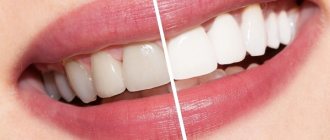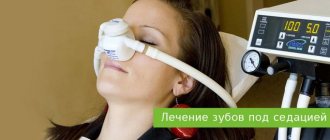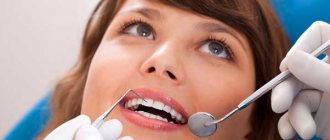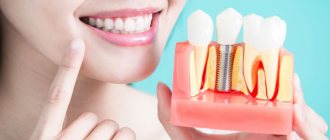According to statistics, about 70% of pregnant women do not visit the dentist. Neglect of treatment is justified by the opinion that anesthesia and dental procedures themselves can harm the fetus and the mother’s body. However, untimely seeking help and foci of infection can cause greater harm: caries, poorly treated root canals, inflammatory processes of the gums, plaque, abscess, periostitis. The neglect of pathological processes is fraught with the entry of microorganisms and their metabolic products into the general bloodstream and the development of a secondary infection.
It is important to remember that it is easier to prevent the disease than to resort to surgical treatment and medication in the future. That is why timely diagnosis and dental treatment during pregnancy is extremely important for maintaining the overall health of the mother and unborn child. In addition, a routine examination by a dentist is included in the list of mandatory examinations when planning pregnancy and during pregnancy.
Features of dental treatment for pregnant women
Dental treatment is a mandatory medical procedure, regardless of whether a woman is preparing to conceive a child or is already pregnant. The dentist’s tactics depend on the trimester of pregnancy, its course, the general somatic health status of the pregnant woman and indications for treatment. Peculiarities of management of pregnant women are characterized by the following features:
Treatment planning
During pregnancy, emergency dental treatment is performed, the indications for which are:
- Carious lesions of hard and soft tissues of teeth: pulpitis, periodontal inflammation (periodontitis).
- Pathological processes of soft tissues of the oral cavity, gums: gingivitis, stomatitis, cheilitis, glossitis, inflammation of periodontal tissues.
- Tooth injuries: fracture of the crown or root of the tooth, dislocation, cracks and chips of the crown part.
- Abscesses.
- Acute purulent inflammation of the jaw bone tissue.
Planned therapy (orthodontic, implantological and orthopedic treatment) is postponed to the postpartum period.
Pregnancy data
Before starting treatment, you should inform your doctor about the duration and course of pregnancy, taking medications prescribed before conception and during pregnancy, and bad habits. These data can significantly affect the treatment plan drawn up by the dentist.
X-ray diagnostics
X-ray examination is extremely undesirable in all trimesters of pregnancy: failures in the formation of fetal cells can lead to irreparable consequences and abnormalities. The 1st and 3rd trimesters are especially dangerous for radiation diagnostics, however, the 2nd trimester is no exception, although it includes lower risks of developing pathology.
Dental filling
When filling teeth, materials of both chemical and light curing are used. Curing lamps used for curing are also not safe for the developing fetus.
Anesthesia
At the present stage of development of dentistry, painkillers are produced that are absolutely harmless to the pregnant woman and the fetus. High-quality anesthesia is half the success of treatment.
We know that it is possible to treat in a certain trimester
Literature
- Pistorius J, Kraft J, Willershausen B. Dental treatment concepts for pregnant patients – results of a survey. Eur J Med Res. 2003 Jun 30; 8(6):241-6.
- Pina PM, Douglass J. Practices and opinions of Connecticut general dentists regarding dental treatment during pregnancy. Gen Dent. 2011 Jan-Feb; 59(1):e25-31.
- Wilder R, Robinson C, Jared HL, Lieff S, Boggess K. Obstetricians' knowledge and practice behaviors concerning periodontal health and preterm delivery and low birth weight. J Dent Hyg. 2007 Fall; 81(4):81.
- George A, Shamim S, Johnson M, Dahlen H, Ajwani S, Bhole S, Yeo AE. How do dental and prenatal care practitioners perceive dental care during pregnancy? Current evidence and implications. Birth. 2012 Sep;39(3):238-47
- Kidd E, Fejerskov O. Essentials of dental caries. 3rd ed. Oxford: Oxford University Press; 2005. pp. 88–108.
- Amini H, Casimassimo PS. Prenatal dental care: A review. Gen Dent. 2010; 58:176–18
- Vergnes JN, Sixou M. Preterm low birth weight and maternal periodontal status: A meta-analysis. Am J Obstet Gynecol. 2007; 196:135.e1–135.e7.
- Xiong X, Buekens P, Fraser WD, Beck J, Offenbacher S. Periodontal disease and adverse pregnancy outcomes: a systematic review. BJOG. Feb 2006; 113(2):135-43.
- López NJ, Da Silva I, Ipinza J, Gutiérrez J. Periodontal therapy reduces the rate of preterm low birth weight in women with pregnancy-associated gingivitis. J Periodontol. 2005;76(11 Suppl):2144–53.
- Lee JM, Shin TJ. Use of local anesthetics for dental treatment during pregnancy; safety for parturient. J Dent Anesth Pain Med. 2017 Jun; 17(2):81-90. Translation of this article into Russian: Use of local anesthetics for dental treatment during pregnancy; safety for women in labor.
- Yu CK, Yuen VM, Wong GT, Irwin MG. The effects of anesthesia on the developing brain: a summary of the clinical evidence. F1000Res. 2013 Aug 2;2:166.
- Strasser K, Huch A, Huch R, Uihein M. Placental transfer of carticaine (Ultracain) a new local anesthetic agent. Z Geburtshilfe Perinatol. 1977 Apr; 181(2):118-20.
- Morgan CD, Sandler M, Panigel M. Placental transfer of catecholamines in vitro and in vivo. Am J Obstet Gynecol 1972; 112:1068–75.
- Haas A. An update on local anesthetics in dentistry. J Can Dent Assoc. 2002 Oct; 68(9):546-51.
- Hirsch KS, Fritz HI. Teratogenic effects of mescaline, epinephrine, and norepinephrine in the hamster. Teratology. 1981 Jun; 23(3):287-91.
- Hood DD, Dewan DM, James FM., 3rd Maternal and fetal effects of epinephrine in gravid ewes. Anesthesiology. 1986; 64:610–613.
- Mike Samuels, Nancy Samuels. New Well Pregnancy Book: Completely Revised and Updated. 1996
- Hagai A, Diav-Citrin O, Shechtman S, Ornoy A. Pregnancy outcome after in utero exposure to local anesthetics as part of dental treatment: A prospective comparative cohort study. J Am Dent Assoc. 2015 Aug; 146(8):572-580.
- Best AM. More on local anesthetics in pregnancy. J Am Dent Assoc. Dec 2015; 146(12):868-9.
- https://www.drugs.com/pro/articaine-and-epinephrine-injection.html
- Malamed SF. Handbook of local anesthesia. 4th ed. St. Louis, Mosby; 1997.
Contraindications and limitations to treatment
A contraindication to dental treatment for a pregnant woman is any procedure that can directly or indirectly harm the body and cause premature birth. Such procedures include the following:
Implant treatment
Both healthy fetal development and complete implant healing require large amounts of calcium. During pregnancy, the body is unable to produce enough mineral to support both processes. Even taking vitamin and mineral complexes sometimes does not give the desired effect. Therefore, every gram of calcium counts.
An additional danger during treatment is the need for X-ray monitoring of the implant installation, as well as the prescription of medications during the recovery period. The latter can have a general toxic effect not only on the pregnant woman’s body, but also on the developmental processes of the fetus.
Professional whitening
During bleaching, the enamel is damaged, which due to pregnancy may be somewhat depleted in mineral composition. Due to the fact that most of the calcium produced goes into the fetus's body, it may not be enough to restore the top layer of enamel. The result is increased sensitivity and microcracks.
Prosthetics
Installation of fixed dentures requires special preparation: preparing the tooth and forming a stump for the crown, removing the dental pulp, filling the root canals. The installation of crowns is contraindicated for pregnant women in the 1st and 3rd trimesters. In the 2nd trimester, in emergency situations, removable prosthetics are allowed.
Tooth extraction
Removal of teeth that are not the cause of discomfort (impacted or dystopic) is contraindicated during pregnancy. If there is a possibility of rescheduling the operation and there are no obvious clinical signs (pain, redness and swelling of the gums), then in order to prevent the development of infection, it is better to refuse the procedure before delivery.
Emergency cases requiring immediate tooth extraction:
- Fracture of the root or crown of a tooth.
- Pulpitis of wisdom teeth.
- Carious lesions of the tooth root.
- Periodontitis.
- Tooth root cysts.
- Destruction of more than 50% of the tooth, accompanied by unbearable pain.
Antibacterial therapy
Antibiotics during pregnancy are prescribed strictly according to indications and taking into account the duration of pregnancy. For treatment, those groups of drugs that do not have a teratogenic effect are selected.
When is anesthesia needed?
Although anesthesia is available during pregnancy, your doctor will try to avoid a painkiller injection if it is not necessary. For example, when a patient presents with an uncomplicated form of caries, treatment can be painless. Painful sensations often depend on the individual sensitivity and mood of the woman, so you should inform your doctor about your characteristics in advance. You cannot do without anesthesia if the patient needs to be treated for deep caries, periodontitis, a dental cyst, or if a tooth needs to be removed.
Dental treatment in the I, II and III trimesters
The dentist’s tactics when treating teeth in pregnant women depend on the specific stage of pregnancy - trimester.
Treatment in the first trimester
The first trimester is the time from the 1st to the 13th weeks of pregnancy. This period is characterized by the formation of the rudiments of the organs of the unborn child. At the same time, the placenta does not yet provide adequate protection of the fetus from the influence of factors of the external and internal environment of the mother’s body.
In the first trimester, a pregnant woman is worried about toxicosis, manifested by systematic nausea, short-term vomiting, hypersalivation, slight dizziness, and slight hyperhidrosis. Any, even minor, stress factor can cause a violent reaction in the body, even leading to miscarriage.
In dental treatment, courses of remineralization therapy and professional teeth cleaning without the use of ultrasound are acceptable. Filling, tooth extraction, prosthetics, dental implantation and x-ray diagnostics are contraindicated during this period.
Treatment in the second trimester
The second trimester lasts from the 14th to the 26th week. The placenta in this trimester is fully formed and provides reliable protection for the fetus. Dental treatment carries fewer risks, but still requires consultation with a gynecologist. During this period, you can perform dental fillings, surgical treatment (strictly according to indications), therapy for inflammatory diseases that may worsen by the 3rd trimester or after childbirth, professional removal of dental plaque (hard and soft).
Treatment in the third trimester
The third trimester is the period from the 27th week until birth. During this period, the woman’s body is actively preparing for childbirth, and therefore may be somewhat weakened. A pregnant woman experiences tachycardia, increased breathing, shortness of breath, decreased blood pressure, and increased anxiety. The woman constantly feels tired. Treatment in the 3rd trimester is exclusively emergency. Planned procedures are postponed until the postpartum period.
In all three trimesters, pregnant women are allowed to carry out professional oral hygiene, the method of which will vary depending on the timing of pregnancy and the condition of the body of the expectant mother.
Story
General anesthetics have been widely used in surgery since 1842, when Crawford Long prescribed diethyl ether to a patient and performed the first painless operation.
On October 16, 1846, American dentist and surgeon Thomas Morton first administered ether anesthesia to a patient to remove a submandibular tumor.
In Russia, the first operation under anesthesia was performed on February 7, 1847 by Pirogov’s friend at the professorial institute, Fyodor Inozemtsev.
Pirogov himself performed the operation using anesthesia a week later. Over the course of a year, 690 operations were performed under anesthesia in 13 cities of Russia, 300 of which were performed by Pirogov!
Soon he took part in military operations in the Caucasus. Here, for the first time in the history of medicine, he began to operate on the wounded with ether anesthesia. In total, the great surgeon performed about 10,000 operations under ether anesthesia.
Principles of pain management
Modern painkillers used in dental practice do not penetrate the placenta and do not change uteroplacental blood flow. They include a lower dose of the vasoconstrictor component, while the analgesic effectiveness remains high.
The drugs of choice include:
- Ultracaine.
- Scandonest (Mepivacaine).
- Ubistezin.
- Alfacaine.
It is not advisable to use lidocaine for local anesthesia, as this drug can cause convulsions, pressure changes, severe dizziness, vomiting and muscle weakness. Carrying out pain relief during tooth extraction or therapeutic treatment must be done under strict monitoring of the pregnant woman’s condition – blood pressure, respiratory rate, pulse.
Local anesthetics are not absorbed into the general bloodstream, as they are inactivated by local tissue factors. The entire volume of the anesthetic substance acts only at the site of its injection. Dental treatment during pregnancy under general anesthesia or sedation is strictly contraindicated.
conclusions
- Anesthesia can be given to pregnant women. And it is necessary (if required).
- There is no special anesthetic for pregnant women.
- Some stories about the dangers of anesthesia refer to general anesthesia, not local anesthesia (and there is still a lot of uncertainty there).
- Modern anesthetics are better than the old ones, but they are not completely harmless.
- Anesthesia with adrenaline can be done, and in most cases it is even desirable.
- Adrenaline reduces the tone of the uterus; there have been no miscarriages caused by local anesthesia.
- Local anesthesia in dentistry is not completely safe. It is necessary to balance between the expected benefits and possible risks.
- Of the drugs, 4% articaine with an adrenaline concentration of 1:200,000 is preferable.
- You can also use articaine with an adrenaline concentration of 1:100,000, mepivacaine without adrenaline, lidocaine with adrenaline.
Carrying out procedures
All dental procedures are carried out after a preliminary consultation with a gynecologist and a general assessment of the need for dental intervention. A thorough examination and high-quality anesthesia are the key to effective treatment of diseases of the hard and soft tissues of the oral cavity.
Regular examination by a dentist and timely prevention of oral diseases are integral components of the health of the mother and fetus. You should not put off visiting a specialist and hope that the problem will solve itself. Modern dentistry has made a big leap in treatment, pain relief and treatment procedures for pregnant women, so if you doubt whether it is worth treating your teeth during pregnancy, then yes, it is definitely worth it.
Therapy
| Service | price, rub. |
| Primary consultation and examination with a doctor | For free |
| Initial consultation with an implantologist, orthodontist, orthopedist (orthopantomogram is required) | For free |
| Repeated examination without prescribing treatment | For free |
| Examination by a doctor with prescription of medication | 500 |
| Help for antenatal clinics, hospitals, sanatoriums | 500 |
| TREATMENT OF CARIES | |
| Treatment of caries “without drilling” ICON technology – 1 tooth | 3000 |
| Treatment of caries (filling, anesthesia, lining) | 2700 — 4200 |
| Treatment of deep caries (filling, anesthesia, x-ray, lining) | 3800 — 5100 |
| Artistic tooth restoration (frontal group of teeth) | 4800 — 6700 |
| Restoration of a chewing tooth (filling, gasket, anesthesia, x-ray, pin) | 3600 — 4600 |
| NERVE REMOVAL – CANAL TREATMENT (depulpation) is carried out in two visits, payment in stages, includes x-rays, anesthesia, canal treatment, temporary filling | |
| Treatment of pulpitis of a 1-canal tooth, without the cost of a filling | 4400 — 5500 |
| Treatment of pulpitis of a 2-channel tooth, without the cost of a filling | 6500 — 7600 |
| Treatment of pulpitis of a 3-channel tooth, without the cost of a filling | 8600 — 9700 |
| Treatment of pulpitis of a 4-channel tooth, without the cost of a filling | 10700 — 11800 |
| Installing a seal | 3200 — 3600 |
Consultation is free.
Risks
In general, general anesthesia is safe. Even very sick patients can be safely anesthetized. The surgical procedure itself involves much greater risk.
Modern general anesthesia is an incredibly safe procedure.
However, older adults and those undergoing lengthy procedures are most at risk for complications . These findings may include postoperative confusion , heart attack, pneumonia, and stroke.
Some specific conditions increase the risk for a patient undergoing general anesthesia, for example:
- obstructive sleep apnea, a condition in which people stop breathing while sleeping
- seizures
- existing heart, kidney or lung disease
- high blood pressure
- alcoholism
- smoking
- previous negative reactions to anesthesia
- medications that may increase bleeding - aspirin, warfarin , for example
- drug allergy
- diabetes
- obesity or overweight
Spinal or epidural?
These two types of pain relief are very often confused, because they are really similar in appearance, especially for those who are far from medicine. However, there are differences between them.
Spinal . This anesthesia uses a thin needle through which an anesthetic is injected into the cerebrospinal fluid. Nowadays, this method is used less and less, because if performed incorrectly or if contraindications are not identified, it can lead to serious consequences.
Epidural . For this type of anesthesia, local anesthesia is first performed, after which a puncture is made at the puncture site with a special needle that penetrates to the dura mater. When performing this manipulation, it is very important not to move so that the doctor’s hand does not tremble. A catheter is inserted into the puncture through a needle, through which anesthetics enter the epidural space. His tube will remain in your back as long as necessary to maintain the pain-relieving effects of the medications. After removing the catheter, only a small puncture will remain, which will be treated and covered with a bandage.
How else to make childbirth easier
Not all women necessarily want to give birth using anesthesia. However, even in this case, you can make the birth process easier for yourself.
- Pregnancy needs to be planned well in advance, giving up all bad habits, building a diet and daily routine, seeing a doctor and trying to avoid stress if possible.
- Before giving birth, you need to attend training courses in it, where you will be told in detail about how to breathe correctly and what to do when contractions begin. Such lessons are needed in order to prepare not only physically, but also emotionally.
- During contractions, you can use some massage techniques: they are usually discussed in courses. In addition, it is very important to breathe properly and try not to scream, as this takes oxygen away from the child











